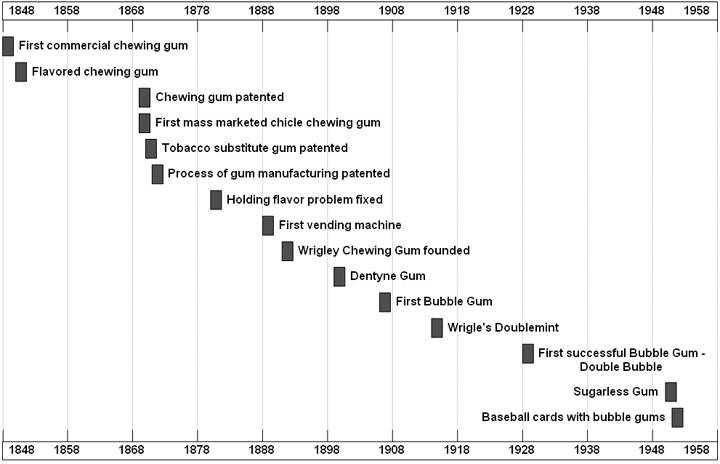Chewing Gum Timeline
Important milestones in chewing gum history:
- Thousands of years ago people chewed gum in its natural form. The most common type of ancient chewing gum were tree resin lumps, various sweet grasses, leaves, grains, and waxes.
- The world's oldest chewing gum is 9000 years old. Recently, archaeologists found three wads of 9000-year-old chewed birch resin on the Swedish island of Orust.
- For centuries, the ancient Greeks chewed a gummy substance named Mastiche, derived from the mastic tree resin. The word "mastic" in Greek means "to chew." For at least 2,400 years, mastic has been used, principally as chewing gum.
- In the 2nd century, Central American Indians and the Mayan civilization chewed the coagulated sap of the Sapodilla tree.
- North American Indians chewed the sap from spruce trees.
- In 1848, the first commercial chewing gum was made and sold by John Bacon Curtis. He experimented with spruce tree resin and made a sticky, rubbery material that could be chewed. This gum was called the State of Maine Pure Spruce Gum.
- In 1850, John B. Curtis added flavor to the gum and paraffin for a soft and rubbery feel. These flavored paraffin gums are becoming more popular than spruce gums.
- On July 27, 1869, Amos Tyler received the first patent in the United States for chewing gum, but he never sold his gum commercially.
- On December 1869, William Finley Semple of Mount Vernon, Ohio, obtained the first chewing gum patent (patent number 98,304). However, Semple never commercially made chewing gums.
- In 1869, Mexican General Antonio Lopez de Santa Anna told Thomas Adams his idea of chicle (for chewing gum).
- In 1869, Thomas Adams added flavor to the chicle. The first mass-marketed chewing gum was called Adams New York Chewing Gum.
- On September 27, 1870, Weaton W. Kilbourn obtained the patent (number 107,883) for a tobacco substitute gum.
- On February 14, 1871, Thomas Adams obtained the patent (number 111,798) for a process to manufacture gum.
- In 1871, Thomas Adams patented a machine to manufacture gum. The same year Adams created a licorice-flavored gum called Black Jack.
- In the 1870s, Adams & Sons sold "Sour Orange" flavored gum as an after-dinner candy.
- In 1880, problem with holding flavor was fixed when William White combined sugar and corn syrup with chicle. He added peppermint extract for a better taste. This peppermint-flavored gum was called Yucatan gum.
- In 1880, Henry Fleer and Frank Fleer experimented with chicle from the sapodilla tree. Fleer brothers made cubes of the chicle substance and overlayed the cubes with sweet material. They called his gums "Chiclets."
- In 1888, Thomas Adams' chewing gum, Tutti-Frutti, was the first chewing gum sold from a vending machine. This first chewing gum vending machine was located in one of the New York City subway stations.
- In 1891, William Wrigley Jr founded Wrigley Chewing Gum.
- In 1892, Mr. Wrigley got the idea of offering two packages of chewing gum with each can of baking powder. This offer was a huge success!
- In 1893, Wrigley's first two brands were Lotta and Vassar, and Wrigley's Spearmint was introduced later that same year.
- Dr. Edward Beeman invented gum that was supposed to serve as a "digestive aid" by adding pepsin powder. This type of gum is still available today.
- In 1899, New York druggist Franklin V. Canning invented Dentyne gum.
- In the late 19th century, significant competition existed in the USA chewing gum market.
- By the early 1900s, gum was well on its way to its current popularity. Wrigley brands became known the world over.
- In 1906, Frank Fleer invented the world's first bubble gum called Blibber-Blubber. However, that gum was too sticky to enjoy and never sold well.
- In 1914, Wrigley's Doublemint, a famous brand, was created when William Wrigley and Henry Fleer added mint and fruit extracts to chewing gum with chicle. Wrigley's Doublemint factories were established in Canada (1910), Australia (1915), Great Britain (1927), and New Zealand (1939).
- In 1928, an accountant for the Fleer gum company Walter Diemer accidentally found bubble gum that was not sticky. He called it Double Bubble. This pink-colored gum was based on the original Frank Fleer formula.
- In the 1950s, Sugarless gum was introduced. The original idea behind sugar-free gum belongs to a dentist, Dr. Petrulis.
- In 1951, the Topps Company reinvented the popularity of bubble gum by adding baseball cards to a package, replacing their previous gift of a single cigarette.
- In the late 1960s, the first sugar-free bubble gum called Blammo was introduced.
